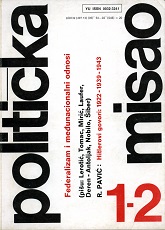Hitlerove geopolitičke koncepcije 1922— 1939—1943.
Hitler's Geopolitical Concepts 1922-1939-1943
Author(s): Radovan PavićSubject(s): Politics, Political Sciences, Interwar Period (1920 - 1939), WW II and following years (1940 - 1949), Fascism, Nazism and WW II, Geopolitics
Published by: Fakultet političkih znanosti u Zagrebu
Keywords: Hitler; Geopolitical Concepts; Geopolitics;
Summary/Abstract: The ideas and practice of Lebensraum and territorial conquest are essential components of fascism. The Nazi geopolitical concept of blood and soil was in effect the prelude to the idea of Lebensraum. Tins concept implies the idea that a nation is tied to its soil, the corresponding natural and cultural milieu and historical tradition. This is why, for example. Hitler did not see a solution to the "Sudeten question" in the removal of the Sudeten Germans to Germany but rather in the conquest of the Sudeten territory. At the same time, in stressing the linkage of the nation to territory, attention is drawn to the shortage of space for the existence of present and future generations, and to the need to obtain it by conquest. For Hitler, this space for future massive peasant colonisation is to be found in the East. The treatment of space in Nazism has three distinct aspects: (a) revanchist, provoked by the reduction of the German Lebensraum by the Treaty of Versailles; (b) conquest, reflected in the efforts to occupy new Euroasian Lebensraum; and (c) colonial, reflected in the ambition to restore old and win new colonies. All three aspects are considered in detail, together with the causes of the failure of Hilter's "new colonialism".
Journal: Politička Misao
- Issue Year: XXII/1985
- Issue No: 01+02
- Page Range: 84-104
- Page Count: 18
- Language: Croatian

